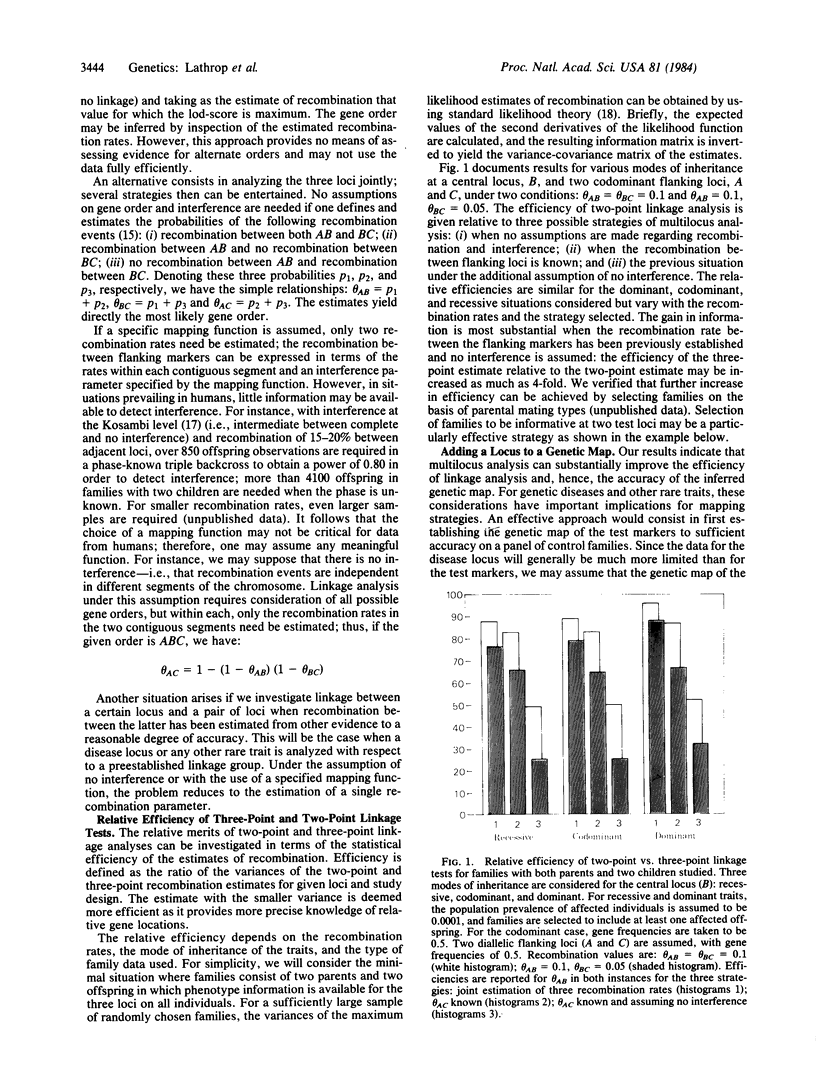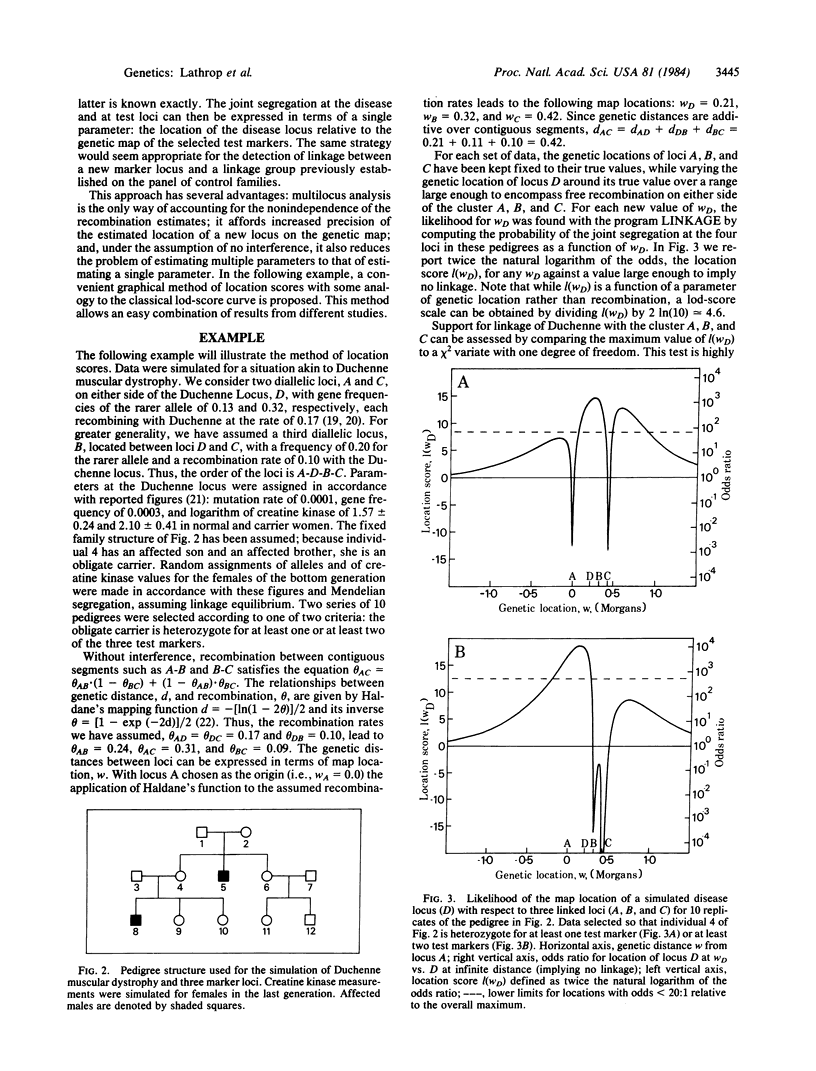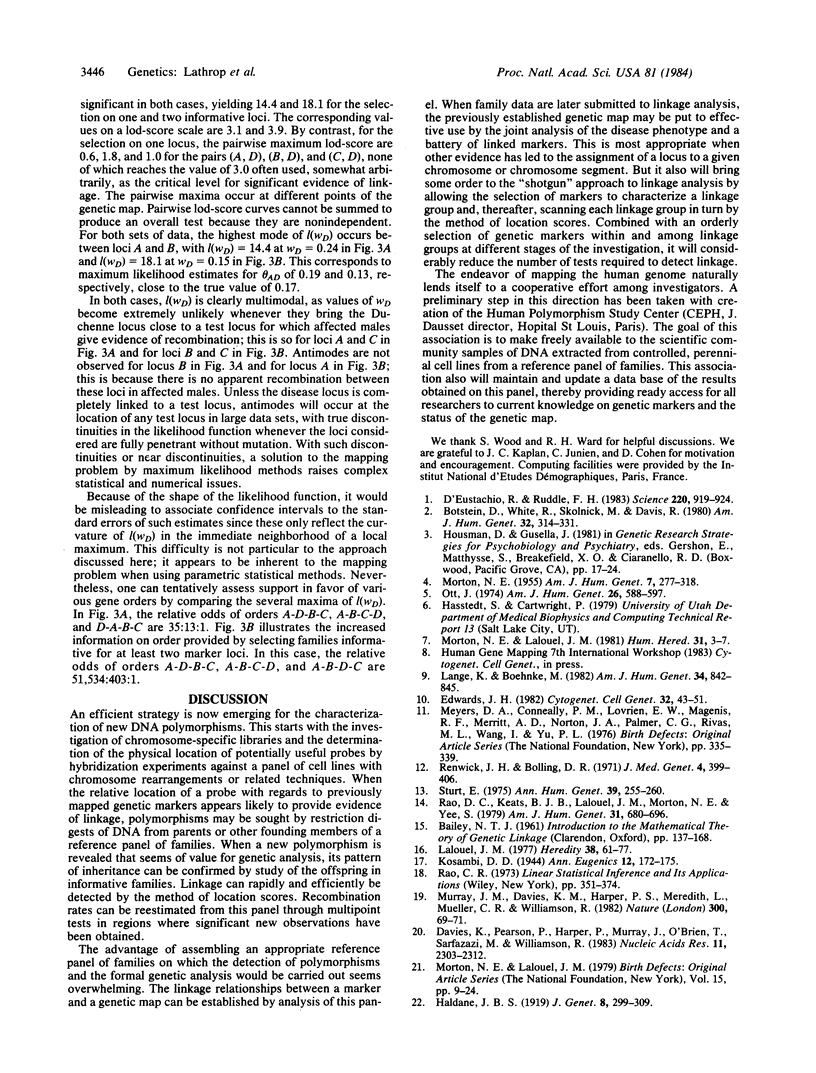Abstract
The increasing number of DNA polymorphisms characterized in humans will soon allow the construction of fine genetic maps of human chromosomes. This advance calls for a reexamination of current methodologies for linkage analysis by the family method. We have investigated the relative efficiency of two-point and three-point linkage tests for the detection of linkage and the estimation of recombination in a variety of situations. This led us to develop the computer program LINKAGE to perform multilocus linkage analysis. The investigation also enables us to propose a method of location scores for the efficient detection of linkage between a disease locus, or a new genetic marker, and a linkage group previously established from a reference panel of families. The method is illustrated by an application to simulated pedigree data in a situation akin to Duchenne muscular dystrophy. These results show that considerable economy and efficiency can be brought to the mapping endeavor by resorting to appropriate strategies of detecting linkage and by constructing the human genetic map on a common reference panel of families.
Full text
PDF



Images in this article
Selected References
These references are in PubMed. This may not be the complete list of references from this article.
- Botstein D., White R. L., Skolnick M., Davis R. W. Construction of a genetic linkage map in man using restriction fragment length polymorphisms. Am J Hum Genet. 1980 May;32(3):314–331. [PMC free article] [PubMed] [Google Scholar]
- D'Eustachio P., Ruddle F. H. Somatic cell genetics and gene families. Science. 1983 May 27;220(4600):919–924. doi: 10.1126/science.6573776. [DOI] [PubMed] [Google Scholar]
- Davies K. E., Pearson P. L., Harper P. S., Murray J. M., O'Brien T., Sarfarazi M., Williamson R. Linkage analysis of two cloned DNA sequences flanking the Duchenne muscular dystrophy locus on the short arm of the human X chromosome. Nucleic Acids Res. 1983 Apr 25;11(8):2303–2312. doi: 10.1093/nar/11.8.2303. [DOI] [PMC free article] [PubMed] [Google Scholar]
- Edwards J. H. The use of computers. Cytogenet Cell Genet. 1982;32(1-4):43–51. doi: 10.1159/000131685. [DOI] [PubMed] [Google Scholar]
- Lalouel J. M. Linkage mapping from pair-wise recombination data. Heredity (Edinb) 1977 Feb;38(1):61–77. doi: 10.1038/hdy.1977.8. [DOI] [PubMed] [Google Scholar]
- Lange K., Boehnke M. How many polymorphic genes will it take to span the human genome? Am J Hum Genet. 1982 Nov;34(6):842–845. [PMC free article] [PubMed] [Google Scholar]
- MORTON N. E. Sequential tests for the detection of linkage. Am J Hum Genet. 1955 Sep;7(3):277–318. [PMC free article] [PubMed] [Google Scholar]
- Meyers D. A., Conneally P. M., Lovrien E. W., Magenis R. E., Merritt A. D., Norton J. A., Palmer C. G., Rivas M. L., Wang L., Yu P. L. Linkage group I: the simultaneous estimation of recombination and interference. Birth Defects Orig Artic Ser. 1976;12(7):335–339. [PubMed] [Google Scholar]
- Morton N. E., Lalouel J. M. Resolution of linkage for irregular phenotype systems. Hum Hered. 1981;31(1):3–7. doi: 10.1159/000153168. [DOI] [PubMed] [Google Scholar]
- Murray J. M., Davies K. E., Harper P. S., Meredith L., Mueller C. R., Williamson R. Linkage relationship of a cloned DNA sequence on the short arm of the X chromosome to Duchenne muscular dystrophy. Nature. 1982 Nov 4;300(5887):69–71. doi: 10.1038/300069a0. [DOI] [PubMed] [Google Scholar]
- Ott J. Estimation of the recombination fraction in human pedigrees: efficient computation of the likelihood for human linkage studies. Am J Hum Genet. 1974 Sep;26(5):588–597. [PMC free article] [PubMed] [Google Scholar]
- Rao D. C., Keats B. J., Lalouel J. M., Morton N. E., Yee S. A maximum likelihood map of chromosome 1. Am J Hum Genet. 1979 Nov;31(6):680–696. [PMC free article] [PubMed] [Google Scholar]
- Renwick J. H., Bolling D. R. An analysis procedure illustrated on a triple linkage of use for prenatal diagnosis of myotonic dystrophy. J Med Genet. 1971 Dec;8(4):399–406. doi: 10.1136/jmg.8.4.399. [DOI] [PMC free article] [PubMed] [Google Scholar]
- Sturt E. The use of lod scores for the determination of the order of loci on a chromosome. Ann Hum Genet. 1975 Oct;39(2):255–260. doi: 10.1111/j.1469-1809.1975.tb00127.x. [DOI] [PubMed] [Google Scholar]



